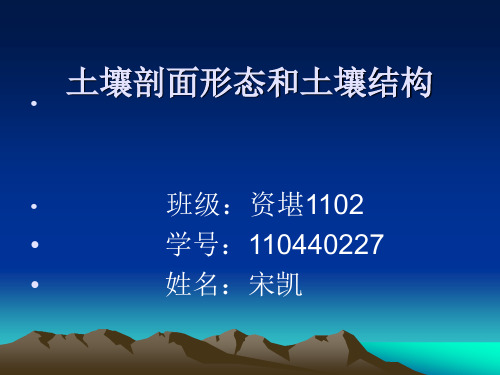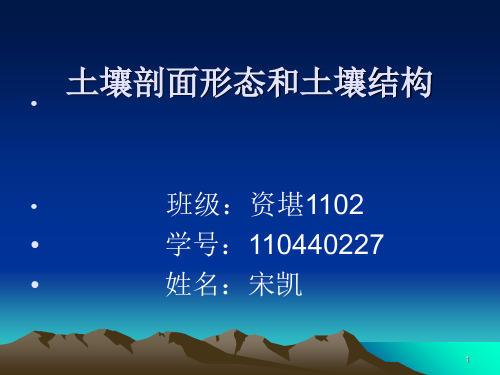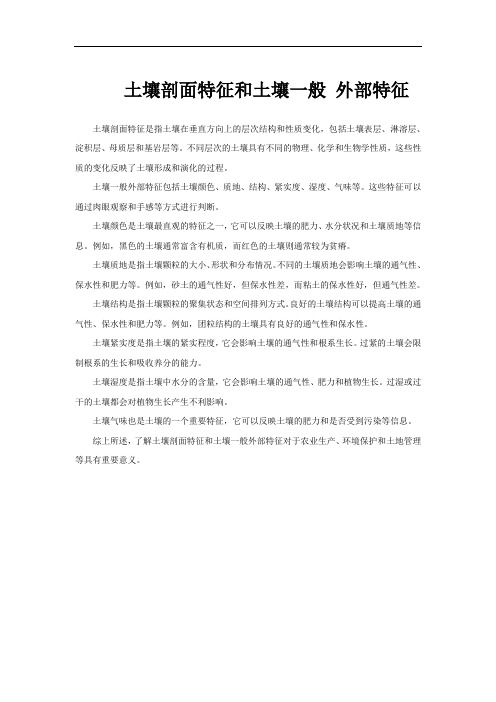不同剖面构型对土壤肥力性质及作物生长状况的影响
土壤剖面形态的发生学

土壤剖面形态的发生学土壤剖面形态的发生学是一门研究土壤形成、形态、性质及管理的学科。
以下是对土壤剖面形态的发生学的主要内容的概述。
1.土壤形成因素土壤形成因素主要包括气候、地形、母质、植被和生物等因素。
这些因素相互作用,共同影响着土壤的形成和发育过程。
2.土壤母质与地形土壤母质是土壤形成的基础,它影响着土壤的矿物组成、质地、结构和肥力等。
地形则通过影响水文、气候和生物等因素,进而影响土壤的形成和分布。
3.气候与植被气候对土壤的形成起着重要作用,不同的气候条件会影响土壤的质地、结构和水分状况等。
同时,植被也对土壤形成产生重要影响,不同的植物种类和生长方式会影响土壤的肥力和结构。
4.土壤生物与土壤有机质土壤生物是影响土壤形成和发育的重要因素之一,包括微生物、植物和动物等。
它们通过分解有机质、矿化矿物和提供养分等,对土壤的肥力和结构产生重要影响。
5.土壤剖面形态与土壤性质土壤剖面形态是土壤性质的综合体现,包括土壤层次、颜色、质地、结构和水分状况等。
通过对土壤剖面形态的观察和分析,可以了解土壤的性质和发育状况。
6.土壤分类与命名根据土壤剖面形态和性质,可以将土壤进行分类和命名。
国际上通用的土壤分类系统包括土纲、亚纲、土类、亚类、土属、土种和亚种等等级。
通过分类和命名,可以更好地了解和识别不同类型的土壤。
7.土壤资源评价与管理土壤资源评价是对土壤的肥力、环境质量和可持续利用潜力等方面的评估。
通过评价,可以了解土壤资源的现状和问题,为制定管理措施提供依据。
同时,采取合理的土地利用方式和保护措施,可以提高土壤质量,维护生态平衡。
8.土壤改良与保护针对不良土壤类型或受到污染的土壤,采取相应的改良措施,提高其生产力和环境质量。
同时,通过保护性耕作、植树造林等措施,防止水土流失和风蚀沙化,保护土壤生态环境。
土地利用规划》形考作业参考答案

土地利用规划》形考作业参考答案参考答案:土地利用规划包括以下内容:1)土地利用总体规划,包括土地利用总体方案、土地利用总体结构、土地利用总量控制等;2)土地利用详细规划,包括城乡建设用地规划、农村土地利用规划、生态保护与恢复规划等;3)土地利用实施方案,包括土地利用实施的时间、步骤、方式、措施等;4)土地利用监测与评估,包括对土地利用实施效果的监测和评估,及时发现问题并进行调整和改进;5)土地利用管理制度,包括土地利用管理的法律法规、政策措施、管理机构等。
土地利用规划是一项长期、系统、综合的工作,需要不断地进行调整和完善,以适应社会经济发展和自然环境变化的需要。
土地利用规划根据范围或层次的不同可分为三种类型:第一种是包括区域内全部土地的土地利用总体规划,其主要目的是确定各类用地规模和空间布局;第二种是针对耕地、草地、林地等单一土地利用系统的详细利用规划,其主要内容是内部土地利用组织,以提高土地利用率和产出率;第三种是为了解决特定土地利用问题而制定的土地利用专项规划,包括防止土地退化和保护生态环境的土地保护规划、合理开发利用未利用土地的土地开发规划,以及土地复垦规划和土地整理规划等。
气象因素对土地特性的影响包括:太阳辐射与作物生长、温度条件与土地利用、降水与土地利用和保护以及风对农业生产的影响。
不同地貌类型对土地特性的影响也不同。
山地丘陵区容易产生水土流失,因此在利用管理上需要重视水土保持措施。
此外,土层薄、土壤粗骨性等特点也需要考虑。
石质山地不适宜种植需要耕作的作物,而适宜林业或牧业。
在进行土地资源评价和土地利用决策时,需要注意坡度因素、山区土地资源的垂直分布规律和缺水问题等。
平原区的共同特点是地形平坦、土层深厚、土壤水分条件较好,因此适宜发展农业和建设用地。
不同类型的平原区也各有其特点,需要因地制宜进行土地利用规划。
土壤构型是指土壤中不同颗粒之间的排列方式和空隙的大小和形状。
土壤构型影响着土壤的通气性、透水性、保水性和根系生长的发育情况。
黄土─土壤结构剖面构型的形成及其重要意义

黄土─土壤结构剖面构型的形成及其重要意义
黄土是中国特殊的土壤类型,由于其在形成过程中凝集了大量细微颗粒,所以其剖面构型特征独特饱满,非常重要。
黄土天然形成,其剖面结构层次分明,从上到下依次为上土层、中土层和底土层,分别由多种不同类型的颗粒组成。
上土层以粗颗粒为主,主要有砂砾、卵石,以及斑砾、片状等,这些粗颗粒有利于提高地面稳定性,防止侵蚀。
中土层以夹层状构造为主,由粒度中等的小卵石、斑砾还有腐殖细㪣组成,这也是黄土的典型结构。
底土层以细颗粒给支持,主要是微粒状的黏土、砂砾及腐殖颗粒等,它们有利于土壤的多孔性,更敏感地响应地下水的变化及充分收集降雨过程中的水分。
黄土的剖面构型,一方面可以改善水文性质,提高土壤肥力,使土壤吸收和保存水分,增加土壤中的有机质含量和碳氮等,另一方面也可以降低水源污染,防止沉积物形成,展现更为出色的水质保护效果。
更重要的是,黄土剖面构型可以缓解气候变化及其破坏的影响,有效减少降雨蒸发和土壤侵蚀,促进坡面植被的生长,形成一个稳定的生态系统,使得土壤提供更多的资源和服务。
总之,黄土剖面构型对人类生存环境至关重要,其形成及维护不仅影响土壤质量,而且还可以缓解气候变化及其破坏,带来更好的环境效益。
土壤剖面各层次的代与特点

B2
B3
自然土壤剖面——母质层
自然土壤剖面
在两个基本发生层之间出现兼有两者特征的称为过 渡层,其符号为AB、BC等。 若两基本发生层犬牙交错,则称指间层,其符号为 A/B、E/B等。
14
自然土壤剖面
在书写形式上,小写英文字母并列紧接于大写字母 之后,可以联合起来表示在同一发生层共同出现的 性质,如 Ah,Ap层。 通常,在联合使用时,小写字母的应用不会多于两 个。
15
自然土壤剖面
自然土壤剖面
耕作土壤剖面
农业土壤的层次分化是农业土壤发育的一般趋势, 由于农业生产条件和自然条件的多样性,致使农业 土壤的土体构型也呈复杂状况,有的层次分化明显, 有的则不明显或不完全。各层厚度差异也较大,因 此田间观察时,应据具体情况进行划分。可大致分 为:
18
耕作土壤剖面
分
土壤。
类
2、耕作土壤剖面——耕作土壤:自然土壤经过人
为的耕作就变成耕作土壤。
5
自然土壤剖面
A 层和B层合称为土体层(solum)。反映 母质层在成土过程影响下已发生深刻的或 一定程度的变化,形成土壤剖面上部土层 的特征。
基本发生层按其发育上的差异可进一步划 分为若干亚层。
6
自然土壤剖面
目前在国际上虽尚无统一的土层命名法,但自1967年国 际土壤学会提出把土壤剖面划分为:O层(有机层)、A 层(腐殖质层)、E层(淋溶层)、B层(淀积层)、C层 (母质层)和R层(基岩)等6个主要土层。
3
土壤剖面
土壤剖面可以表示土壤的外部特征,包括
土壤的若干发生层次、颜色、质地、结构、
作
新生体等。
用
观察和了解土壤剖面是认识土壤、分析鉴
土壤的剖面形态和土壤结构.

• 自然土壤剖面:
• 4、旱地耕作土壤的剖面:
旱地耕作土 壤的剖面: 旱地耕作土 壤剖面一般 也分为四层: 即耕作层(表 土层)、犁底 层(亚表土 层)、心土层 及底土层
耕作层 犁底层 心土层
底土层
旱地耕作土壤剖面
• (1)耕作层 :
概念:又称表土层、熟土层、活土层。 指经常被耕翻的土壤表层,厚15~20 cm。
片状,多出现在粉质土的犁底层和表层: a、 较厚的,称为板状结构; b、 较薄的,称为片状结构; c、 较小的,称为鳞片状结构。
5、单粒结构 土粒彼此不胶结,呈孤立存在。
“松沙土”
(生产中,只有团粒结构是有利于通气透 水和保水保肥的结构体,其余结构体都有各 种各样的生产问题。所以,生产中,把土壤 中有丰富的团粒结构称为有结构土;而其余 结构都归为无结构土)。
断与土体下部相连的毛细 易完全切断,下部土壤水
管,阻止下部水份上升补 份可源源上升补充蒸发,
充蒸发,水份损失小,土 水份损失大,土壤抗旱力
壤抗旱力强。
弱。
有结构土
无结构土
4、团粒内部,常为水份 4、在土壤较干时,有机 占据,有机质行腐化而积 质行矿化释放,但因缺水, 累;团粒之间,常为空气 植物不能吸收养分;当水 所占据,有机质行矿化而 份含量高,植物能够吸收 释放。既有保肥,也有供 养分时,有机质又行腐化 肥,保肥供肥较为协调。 而积累,释放的养分少。
土壤剖面形态和土壤结构
•
•
班级:资堪1102
•
学号:110440227
•
姓名:宋凯
一、土壤剖面形态
1、土壤剖面 2、自然土壤剖面 3、旱地耕作土壤剖面 4、水田耕作土壤剖面
大连市山前平原地带棕壤剖面性状分析

大连市山前平原地带棕壤剖面性状分析采取野外调查与室内分析相结合方法对大连市山前平原地带棕壤剖面理化性质进行了研究,结果表明:(1)研究区棕壤剖面可划分为耕作层、犁底层、心土层、底土层四个发生层;(2)研究区棕壤剖面各发生层的沙粒含量约占3/4,粘粒约占1/4;剖面各发生层土壤的比重从上至下逐渐增大;(3)土壤pH值、有机质含量从上到下依次递减,但由于常年的翻种,耕作层土壤全磷含量最低,犁底层含量最高,再往下,便依次递减。
标签:大连市棕壤剖面性状在自然界中,土壤是联系有机界与无机界的中心环节,是结合地理环境各组成要素的枢纽。
随着时空的变化,土壤综合性状朝着有利于或不利于植物生长的方向演变,并在土壤剖面上留下了各种各样的痕迹。
棕壤是淋溶土的一类,在辽东半岛上分布很广,根据地形母质的不同,有丘陵山地棕壤和平原低地棕壤之分。
之前已有学者对辽南丘陵地区的棕壤进行了分析[1],因此有必要进一步深入大连市境内,对当地山前平原区棕壤理化性质进行分析,以完善对辽南地区棕壤的研究。
1研究区概况2研究方法2.1土样采集在牧城驿选取一处自然边坡为研究对象,经稍加修整后,根据土壤剖面的颜色、结构、质地、松紧度、湿度、植物根系分布等,自上而下划分土层,仔细观察,并描述记载。
观察记载后自下而上的逐层采集分析样品,通常采集各发生土层中部位置的土层,随后将所采样品放入塑料袋内,每层样品采集一公斤左右,并附上标签。
2.2分析方法将采集的土壤样品带回实验室自然风干、制备并分层测定其理化性质,其中土壤的机械组成采用比重计法测定,土壤比重采用比重瓶法测定,pH采用酸度计法,有机质采用重铬酸钾—硫酸氧化法,全磷采用钼锑抗比色法。
3结果与分析3.1棕壤剖面描述研究区耕作土壤自然剖面经整理后可划分成4个典型发生层,自上而下分别为耕作层(0~48cm)、犁底层(48~90cm)、心土层(90~120cm)、底土层(120cm以下)。
由于原生夏绿阔叶林植被不复存在,替而代之的为菜地,故土壤剖面缺失枯枝落叶层。
水稻土剖面的主要层次及特征

水稻土剖面的主要层次及特征
水稻土的剖面结构主要包括以下层次及其特征:
1. 耕作层:在淹水时,这一层水分饱和,呈现半流泥糊状或泥浆状。
当排水落干后,它会变成包含有屑粒、碎块的大块状结构,结构面上有锈斑并杂有植物残体。
2. 犁底层:这一层较紧实,具有暗棕色的垂直结构,发育有锈纹和小铁锰结核。
3. 渗育层:由于水分渗透,这一层的铁质淋洗强烈,颜色较淡。
4. 淀积层:多呈棱块状结构,多锈纹、锈斑和铁锰结核。
5. 潜育层:这是处于还原状态的层次,呈蓝灰色结构。
此外,水稻土剖面还可能包括淀积潜育层,它位于地下水变动范围内,呈灰蓝色,有较多的锈斑和锈纹结构不明显。
总的来说,水稻土的剖面结构复杂而有序,各层次具有独特的物理和化学特性,这些特性共同决定了水稻土的生产性能和肥力状况。
试验九土壤剖面性状观察

实验九 土壤剖面性状观察土壤剖面指的是从地面向下挖掘而裸露的垂直切面。
土壤剖面中的层次和形态特征,能综合地反映各种自然成土因素和人为因素对土壤成土过程,以及土壤内部的物质运动和土壤肥力等方面特性的影响。
所以,观察土壤剖面是研究土壤性质、区分土壤类型的重要方法之一。
土壤剖面形态的鉴别主要指土壤颜色、湿度、质地、结构、松紧度、新生体、pH 值和石灰反应等。
根据上述形态特征观察,结合室内分析材料,可以作为农业生产中合理用地、施肥、改良土壤的参考。
特别在进行土壤分类研究时,剖面形态是土壤分类不可缺少的依据。
一、仪器设备和试剂1.仪器。
土铲、手锄、土钻、剖面刀、土壤坚实度计、土壤色卡、土壤pH 比色卡、记录表、比色瓷盘、布卷尺或折尺、土壤标本盒、布袋或塑料袋、标本盒。
2.试剂。
1.5%铁氰化钾、1:9盐酸、10%盐酸溶液、pH 混合指示剂。
二、剖面观察的步骤1.剖面挖掘与修整。
(1)剖面挖掘。
选择有代表性的地块(可以根据地形、地势、耕作栽培及土壤类型等)确立观察点,避免选在路、渠边、粪堆上或人易干扰的地段。
(2)剖面的大小要根据观察的要求来定,如了解土壤形成发育,要挖大些(长1.5—2.0米,宽0.6一0.8米,深1.5米左右);如只了解土壤与农作物生长关系,可挖小些(长1.2—1.5米,宽0.6—0.8米,深1.0米左右),深度要求达到母质层或地下水位为度。
(图21)。
(3)选取土坑一端的壁面为观察剖面,要求向阳,而在另一端做好阶梯,以便下坑观测。
(4)掘坑时,应将表土堆于一侧,下层土壤堆于另一侧,观察完毕后,应将底土仍填回下层,表土填回到上层。
观察壁面的上部不准堆土和践踏。
(5)剖面修整。
土坑挖成后,将观察壁面用土铲向下垂直铲平,然后用切土刀自上而下轻轻拨落表面土块,以便露出自然结构面。
整修剖面时,可保留一部分已铲平之壁面,因平整的壁面易于分清各土层的界限。
如需采取底层的土壤标本,则应在修正剖面前采取,以免修整时污染底层土壤。
土壤的剖面形态和土壤结构

母质层
位于淀积层之下,是土壤发育 的基础,其特征取决于成土母 岩的性质。
岩石层
位于最下层,由岩石构成,无 明显层次。
土壤剖面的颜色和质地
颜色
土壤颜色可以反映其发育程度和所含 矿物的类型,如红壤、黄壤等。
质地
土壤质地决定了土壤的松紧程度和肥 力特性,一般分为砂土、壤土和黏土。
土壤剖面的石块和侵入体
土壤结构的稳定性
01
土壤结构的稳定性是指土壤抵抗外部力量破坏的能 力,包括抗侵蚀、抗风化和抗变形等。
02
土壤结构的稳定性取决于土壤团聚体的数量和质量, 以及土壤颗粒的组成和排列。
03
保持土壤结构的稳定性对于维护土壤健康、防止水 土流失和提高农业生产具有重要意义。
03 土壤剖面形态与土壤结构 的关系
形象性命名
根据土壤的形态或某些特征进行形象化的命名,如石 块地、石缝地等。
THANKS FOR WATCHING
感谢您的观看
相关。
土壤团聚体的稳定性直接影响土 壤的物理性质和肥力状况,对植
物生长和发育具有重要影响。
土壤质地分类
土壤质地是根据土壤颗粒的组成和比例对土壤进 行分类的一种方法。
常见的土壤质地分类包括砂质土、壤质土、黏质 土和砾质土等。
不同土壤质地对土壤的物理性质、水分保持能力、 养分状况和植物生长具有不同的影响。
地形因素还影响土壤的水分和养分分布,进而影响土壤的肥 力状况。在低洼地区,由于水分聚集,可能形成沼泽或湿地 土壤;而在山坡地带,由于水分流失较快,土壤可能较为干 燥。
母质因素
母质是形成土壤的物质基础,其矿物组成、机械组成、化学性质等对土壤的形成具有重要影响。例如 ,富含石英、长石等矿物的母质容易形成砂质土壤;而富含粘土矿物的母质容易形成粘土质土壤。
长期施肥土壤微生物群落的剖面变化及其与土壤性质的关系

李晨华等: 长期施肥土壤微生物群落的剖面变化及其与土壤性质的关系. / 微生物学报(2014)54(3)
321
壤样品组成混合 代 表 样,所 取 土 样 去 除 杂 物、细 根, 碾碎后 混 匀。 部 分 土 样 保 存 于 - 80℃ 以 备 土 壤 DNA 提取及其后续测定;其余土样风干后过筛测定 土壤理化性质。SOC 与全氮( TN) 用总有机碳 / 总氮 分析仪 ( Multi C / N 3100 ) 测 定,土 壤 pH 与 电 导 (EC)分别采用电位法与电导法( 土水比为 1 ∶ 5) 测 定。 1. 3 土壤总 DNA 提取与焦磷酸测序分析
土壤微生物在维持生态系统结构与功能稳定 过 程 中 发 挥 着 重 要 作 用 。 农 业 生 态 系 统 中 ,不 同 管 理 方 式 通 过 影 响 土 壤 属 性 ,改 变 微 生 物 群 落 结 构 及 其 生 理 生 态 功 能 ,进 而 对 土 壤 质 量 甚 至 是 生 态 环 境 安 全 产 生 影 响 。 研 究 表 明[1 - 2],大 量 氮 肥 的 施 用 通 常 导 致 土 壤 微 生 物 群 落 多 样 性 降 低 、硝 化 微 生 物 群 落 结 构 趋 向 单 一 、土 壤 酸 化 增 强 ,并 造 成 有 机 碳 ( SOC) 损 失 ,进 而 引 起 土 壤 质 量 下 降 与 生 态风险增 加 等 一 系 列 环 境 后 果;而 化 肥 有 机 肥 配
Research Paper 研究报告
长期施肥土壤微生物群落的剖面变化及其与土壤性质的关系
李晨华1 ,张彩霞2,3 ,唐立松1* ,熊正琴2 ,王保战3 ,贾仲君3 ,李彦1
1 荒漠与绿洲生态国家重点实验室,中国科学院新疆生态与地理研究所,新疆 乌鲁木齐 830011 2 南京农业大学农业资源与生态环境研究所,江苏 南京 210095 3 中国科学院南京土壤研究所,土壤与农业可持续发展国家重点实验室,江苏 南京 210008
土壤剖面构型 标准种类

土壤剖面构型标准种类一、土壤层次土壤层次是土壤剖面的重要特征之一,它反映了土壤形成的过程和时间。
根据土壤形成因素和时间顺序,可以将土壤层次分为A、B、C三个层。
A层是新近沉积的或未完全固结的表层,B层是已经固结但仍在进行成土过程的下层,C层则是基岩层。
不同的土壤层次对植物的生长和水分保持有不同的影响。
二、土壤质地土壤质地是指土壤中砂粒、粉粒和粘粒的比例。
根据土壤颗粒的大小,可以将土壤分为砂质土、壤质土和粘质土。
砂质土的颗粒较大,具有良好的通气性和排水性,但保水能力较差;粘质土的颗粒较小,保水能力强,但通气性和排水性较差;壤质土则介于两者之间,具有良好的综合性能。
三、土壤颜色土壤颜色是土壤质量的重要指标之一,它与土壤的有机质含量、矿物质组成和氧化还原状况等因素有关。
一般来说,健康的土壤颜色应为棕色或暗棕色,这表明土壤富含有机质和微生物活性。
如果土壤颜色过浅或过于灰白,则可能表明土壤质量较差。
四、土壤结构土壤结构是指土壤颗粒的排列方式和空隙大小。
良好的土壤结构能够提高土壤的通气性、排水性和保水能力,有利于植物的生长。
常见的土壤结构有团粒结构、片状结构和柱状结构等。
团粒结构的土壤最为理想,具有良好的综合性能;片状结构和柱状结构的土壤则容易出现水土流失和干旱等问题。
五、土壤紧实度土壤紧实度是指土壤颗粒间的压缩程度。
土壤紧实度过高会导致通气性和排水性变差,不利于植物根系的生长;而紧实度过低则容易造成水土流失和风蚀等问题。
因此,适中的土壤紧实度是保持土壤健康的重要条件。
六、土壤有机质土壤有机质是指存在于土壤中的有机物质,包括动植物残体、微生物及其分解产物等。
土壤有机质对改善土壤结构、提高土壤肥力和保持土壤健康具有重要作用。
一般来说,健康的土壤中有机质的含量应占土壤总质量的2%-5%。
七、土壤pH值土壤pH值是指土壤酸碱度的指标,它对植物的生长和土壤微生物活性具有重要影响。
不同植物对土壤pH值的适应性不同,因此了解并调节土壤pH值是实现科学合理种植的重要措施。
不同土体剖面构型对水稻生长与产量的影响

不同土体剖面构型对水稻生长与产量的影响作者:王启龙蔡苗宁松瑞来源:《现代农业科技》2017年第16期摘要为探明韩城下峪口不同土体剖面构型对旱稻生长及产量的影响,2016年在陕西省富平县中试基地开展了5种土体剖面构型对于水稻生长及产量影响的试验。
结果表明,不同处理的土壤耕层水分含量在不同时期有差异,各处理间表现为容重1.8 g/cm3的黄土>1∶3的粉煤灰和沙>1∶2的粉煤灰和沙>容重1.2 g/cm3的黄土>容重1.8 g/cm3的沙土。
不同土体剖面构型影响水稻的株高、分蘖以及产量。
水稻株高、分蘖、产量在处理间表现为1∶2的粉煤灰和沙>容重1.8 g/cm3的黄土>1∶2的粉煤灰和沙>容重1.2 g/cm3的黄土>容重1.8 g/cm3的沙土。
水稻收获后测定的土壤养分指标的大小趋势也是如此。
本试验表明,韩城下峪口土地整治项目区需要进行土体有机重构,综合考虑工程成本和整治效果,适宜参考1∶2的粉煤和沙处理的土体剖面构型。
关键词水稻;剖面构型;生长;产量中图分类号 S282;S511 文献标识码 A 文章编号 1007-5739(2017)16-0011-03Abstract In order to investigate effects of soil profile configuration on growth and yield of rice,related experiments were carried out at Fuping Pilot-base. The results were as follows:the soil water contents of different treatments showed differences,with the values as volumetric loess with bulk density 1.8 g/cm3>fly ash and sand with scale was 1∶3>fly ash and sand with scale was 1∶2>loess with bulk density 1.2 g/cm3>sand with bulk density 1.8 g/cm3.Different soil profiles configuration affected the plant height,tillering and yield. The variation order between plant height,tillering and yield among different treatments was fly ash and sand with scale was 1∶2>loess with bulk density 1.8 g/cm3>fly ash and sand with scale was 1∶3>loess with bulk density 1.2 g/cm3>sand with bulk density 1.8 g/cm3. The trend of soil nutrient after the harvest of rise was similar to the above. Thus,land organic reconstruction to be did in Hancheng Xiayukou land remediation project area. Based on the comprehensive consideration of the project cost and effectiveness,the soil profile configuration suggested fly ash and sand with scale was 1∶2.Key words rice;profile configuration;growth;yield韩城市下峪口土地整治项目区位于韩城市东部黄河右岸滩地内,地理位置介于东经110°30′34″~110°33′36″,北纬35°31′02″~35°34′01″,距离县城10 km,地处黄河川道,地面较为平坦,地域广阔,地表水资源丰富,降雨量较高,加之光热资源充足,自然条件满足种植水稻的发展需求。
土壤剖面各层次的代 与特点

B2 B3
自然土壤剖面——母质层
自然土壤剖面
在两个基本发生层之间出现兼有两者特征的称为过 渡层,其符号为AB、BC等。 若两基本发生层犬牙交错,则称指间层,其符号为 A/B、E/B等。
14
自然土壤剖面
在书写形式上,小写英文字母并列紧接于大写字母 之后,可以联合起来表示在同一发生层共同出现的 性质,如 Ah,Ap层。 通常,在联合使用时,小写字母的应用不会多于两 个。
7
自然土壤剖面
自然土壤剖面
A 层和B层合称为土体层(solum)。反映母质层 在成土过程影响下已发生深刻的或一定程度的变化, 形成土壤剖面上部土层的特征。 基本发生层按其发育上的差异可进一步划分为若干 亚层。
9
自然土壤剖面——覆盖层
O1
O2
自然土壤剖面——淋溶层
A1
A2
A3
自然土壤剖面——沉积层
分
土壤。
类
2、耕作土壤剖面——耕作土壤:自然土壤经过人
为的耕作就变成耕作土壤。
5
自然土壤剖面
A 层和B层合称为土体层(solum)。反映 母质层在成土过程影响下已发生深刻的或 一定程度的变化,形成土壤剖面上部土层 的特征。
基本发生层按其发育上的差异可进一步划 分为若干亚层。
6
自然土壤剖面
目前在国际上虽尚无统一的土层命名法,但自1967年国 际土壤学会提出把土壤剖面划分为:O层(有机层)、A 层(腐殖质层)、E层(淋溶层)、B层(淀积层)、C层 (母质层)和R层(基岩)等6个主要土层。
3
土壤剖面
土壤剖面可以表示土壤的外部特征,包括
土壤的若干发生层次、颜色、质地、结构、
作
新生体等。
用
土壤的剖面形态和土壤结构

•
•
班级:资堪1102
•
学号:110440227
•
姓名:宋凯
1
一、土壤剖面形态
1、土壤剖面 2、自然土壤剖面 3、旱地耕作土壤剖面 4、水田耕作土壤剖面
2
• 1、土壤剖面:从地表向下所挖出的垂直切 面叫土壤剖面。
• 2、发生层:土壤剖面一般是由平行于地表、 外部形态各异的层次组成,这些层次叫土 壤发生层或土层(在土壤形成过程中,由 于物质的迁移和转化,土壤分化成一系列 组成、性质和形态各不相同的层次,称为 发生层 )
旱土中多此类。小于0.25mm的为微团粒,水田中多为此 类
a. 在水中分散的,为粒状结构;
b. 在水中能稳定存在的,为团粒结构。
⑵ 特征:
a.多形成于有机质含量高的土壤表层,以根系附近分布 较多。
b.结构内部,毛管孔隙丰富,蓄水保肥能力强,结构体
之间,通气透水能力强。
30
2、块状结构
土粒结持体沿长、宽、高三向发展,外观形态近 似立方体, 常出现在粘土耕作层或表土层中, 不良结构体: ①大块状结构:直径大于5cm ② 块状结构:3~5cm ③ 碎块状结构:0.5~3cm 3、核状结构 多存在于粘质底土层和心土层中
土壤的结构性是对土壤中土粒存在方式 的一种描述。
土壤中的土粒:或者彼此不粘结,呈单 粒态;或者彼此相互粘结,形成具有一定 形状和大小的团聚体,这种团聚体即为结 构体。
土壤形成结构体的性质以及结构体的特 征就称为土壤的结构性。
29
一、土壤结构体的类型和特征
1、粒状结构和团粒结构
⑴ 土粒的结持体外观形态近似圆球形:0.25~10mm,
土层,也叫半熟化土层。一般厚度为20~ 30 cm。
土壤学实验论文-土壤剖面形态观察及肥力鉴定

土壤学实验论文题目:土壤剖面形态观察及肥力鉴定专业班级:XX级XX班姓名:XXX学号:XXXXXXX指导教师:XXXXX日期:2012.12.25城市绿地土壤特征及其利用管理对策摘要:通过对学校绿地土壤的理化性质的研究分析城市绿地土壤的特征,探讨从城市的整体性出发,以调配与改良为核心的土壤利用管理对策,以此来实现高水准的园林绿化产业,创造出优美的人居生态环境。
关键词:城市绿地土壤利用管理对策前言随着社会经济的发展,城市绿化规模的扩大,植物生长不良的现象在城市中越来越多。
造成这种现象的原因是多方而的,不仅有植物本身、气候和养护管理方面的因素,还和栽植土壤的构成有十分密切的关系[1]。
因为土壤是植物的立基之本,良好的土壤质量能够促进植物的健康生长,这是园林建设的一个基本点,所以在城市园林绿化的实施过程中,为了满足人们对城市绿化环境的更高要求,必须对土壤的物理、化学、生物学特性、肥力特征以及土壤利用、改良和管理进行研究。
1材料与方法1.1材料研究区位于川农大成都校区校园内, 属于成都平原区域。
按研究需要, 分别采集样区内不同地方的土壤,进行试验。
1.2方法土壤的结构是直接眼睛观察;土壤的深度直接在土钻上读取;土壤的质地采用的是手测法;颜色、PH、石灰反应用的是野外土壤速测箱的比色卡,指示剂,盐酸等。
2结果与分析表1 温江校区校园绿地土壤调查通过试验,由表1可知,所采集的所有土壤都有石灰反应,大多数都是湿土,由于土层较薄,大部分都是无结构的,少量则是团块结构,颜色大多是暗灰色,差距不是很明显,质地大多是壤土,少粘土,土壤的PH都靠近中性,表土层的PH较高,而稍底层的PH降低。
由调查结果可以分析:土壤溶液的pH是土壤的重要基本性质,也是影响肥力的重要因素之一,它直接影响土壤中养分的存在状态、转化和有效性。
由表1显示,来自园林区绿地土壤pH平均值彼此接近且偏碱性,而来生产绿地的土壤却呈现酸性。
这说明,成都市市区绿地土壤有碱化的趋势。
土壤剖面特征和土壤一般 外部特征

土壤剖面特征和土壤一般外部特征
土壤剖面特征是指土壤在垂直方向上的层次结构和性质变化,包括土壤表层、淋溶层、淀积层、母质层和基岩层等。
不同层次的土壤具有不同的物理、化学和生物学性质,这些性质的变化反映了土壤形成和演化的过程。
土壤一般外部特征包括土壤颜色、质地、结构、紧实度、湿度、气味等。
这些特征可以通过肉眼观察和手感等方式进行判断。
土壤颜色是土壤最直观的特征之一,它可以反映土壤的肥力、水分状况和土壤质地等信息。
例如,黑色的土壤通常富含有机质,而红色的土壤则通常较为贫瘠。
土壤质地是指土壤颗粒的大小、形状和分布情况。
不同的土壤质地会影响土壤的通气性、保水性和肥力等。
例如,砂土的通气性好,但保水性差,而粘土的保水性好,但通气性差。
土壤结构是指土壤颗粒的聚集状态和空间排列方式。
良好的土壤结构可以提高土壤的通气性、保水性和肥力等。
例如,团粒结构的土壤具有良好的通气性和保水性。
土壤紧实度是指土壤的紧实程度,它会影响土壤的通气性和根系生长。
过紧的土壤会限制根系的生长和吸收养分的能力。
土壤湿度是指土壤中水分的含量,它会影响土壤的通气性、肥力和植物生长。
过湿或过干的土壤都会对植物生长产生不利影响。
土壤气味也是土壤的一个重要特征,它可以反映土壤的肥力和是否受到污染等信息。
综上所述,了解土壤剖面特征和土壤一般外部特征对于农业生产、环境保护和土地管理等具有重要意义。
不同土体剖面构型对水稻生长与产量的影响

d e n s i t y 1 . 8 g / c m3 > n Y sh a a n d s a n d wi t h S C le a Wa s 1 : 3 > l f y sh a nd a s a n d w i t h s c le a w s a 1 : 2 > l o e s s w i t h b u l k d e n s i t y 1 . 2 g , / c m3 > s a n d w i t h b lk u d e n s i t y 1 . 8
( S h a a n x i P r o v i n c i a l L a n dE n g i n e e i r n gC o n s t r u c i t o nG r o u pC o . , L t d . , I n s t i t u t e o f L a n dE n g i n e e i r n g a n dT e c h n o l o g y , S h a a n x i P r o v i n c i lL a a n d
Ef fe c t s o f Di fe r e n t S o i l Pr o i f l e Co n ig f u r a t i o n o n Gr o wt h a n d Yi e l d o f Ri c e
WA NG Qi - I o n g cA I Mi a o ND G S o n g - r u i
土壤剖面的分层及各层的特点

土壤剖面的分层及各层的特点
般来说,人们把土壤分为,B,c三个层,即表土层,心土层,底土层。
表土层又可分为耕作层和犁底层,也叫腐殖质一淋溶层,是熟化土壤的耕作层,在森林覆盖地区有枯枝落叶层;心土层又称“生土层”,是土壤剖面的中层;底土层也叫母质层,是土壤中不受耕作影响,保持母质特点的一层。
1土壤层次的详细介绍
发育良好且未经扰动的土壤剖面大致可分三层。
最上层是表土层,又称淋溶层(A层);第二层是心土层,又称淀积层(B层),第三层是底土层,又称母质层(C层),有时为潜育层(如沼泽土、草甸土的潜育层)。
另外,山地土壤在母质层之下多为母岩层(层)。
表土层的生物积累作用较强,含有较多的腐殖质,肥力较高。
耕作土壤的表土层,又可分为上表土层与下表土层。
上表土层又称耕作层,为熟化程度较高的土层,其肥力、耕性和生产性能最好;下表土层包括犁底层和心土层的最上部分(又称半熟化层)。
表土层的作用是生长植物,为植物提供有利的生长环境,表土层有机质丰富,这层土壤里植物根系最密集。
心土层位于表土层与底土层之间,通常是指表土层以下至50厘米左右深度的土层。
在耕作土壤中,心土层的结构一般较差,养分含量较低,植物根系少。
但是,心土层是起保水保肥作用的重要层次,是生
长后期供应水肥的主要层次。
底土层几乎未受耕作影响,根系极少。
在耕作土壤中如果底土层质地粘重、紧实,可起到一定保水、保肥作用,如果质地较轻、结构松散,则易于漏水、漏肥。
水稻土剖面构型[宝典]
![水稻土剖面构型[宝典]](https://img.taocdn.com/s3/m/425cc17b1fb91a37f111f18583d049649b660e67.png)
水稻土的剖面构型水稻土:各种田质的土壤,经人工垦种水稻,通过水耕熟化作用,发育成具有特殊剖面性态的水稻土,水稻土的剖面的基本特征是耕作层、犁底层、底土层、潜育层,水稻土又分为淹育型、潴育型、渗育型、潜育型、沼泽型、盐渍型及矿毒田等七个水稻土亚类。
1、淹育型水稻土:由于所处地势高亢,地下水位低,形成稻田时间短,水耕熟化程度较低,犁底层浅薄,有的尚未形成,底土层仍保持母土性状,剖面构型为A-P-C或A-C型。
2、潴育型水稻土:水耕时间长,土壤熟化程度高亢,不存在干旱、涝渍、咸、酸、毒等土壤障碍因素,耕作层下面有完整的犁底层,犁底层下面有发育良好的潴育层,潴育层下是潜育层或母质层。
剖面构型为A-P-W-G或A-P-W-C型。
3、渗育型水稻土:土壤长期受侧渗水或下渗水强烈漂洗,铁、锰和粘粒等物质淋失,而成白色粘土层和沙层的渗育层,养分淋失,土壤贫瘠化,剖面构型为A-P-E-C、A-PE-E-C或A-P-W-E型。
4、潜育型水稻土:因地势低,地下水位高,或因水利设施不完善,雨季排水不畅,使土壤剖面较高层次出现潜育层,潜育层在缺氧条件下,还原作用强烈,土壤中铁、锰氧化物被还原成低价铁、锰,使土壤颜色呈黑灰色、青灰色或蓝灰色。
剖面构型A-P-G或P-WG-G型。
5、沼泽型水稻土:地势低洼,地下水位高,或泉水涌出,土壤长期受水浸渍,脱沼过程无法进行,土壤浮烂成糊状,土壤长期处于嫌气状态,还原性强,稻根受亚铁、硫化氢等毒害,常致黑根腐烂。
剖面构型A-G或A-PG-G型。
6、盐渍型水稻土:滨海盐渍沼泽土经人工围垦种植水稻发育而成的。
因成土母质为滨海沉积物,盐分含量高,部分因土层中有红树林残体,有大量硫化物积累,经氧化生成硫酸,使土壤变得又酸又咸,形成咸酸田。
剖面构型为A-P-G 型。
7、矿毒型水稻土:地处矿区下方,受矿区采矿、选矿的废水、废渣的直接污染,致下游长期灌溉污染的水形成矿毒田。
剖面构型A-P-W-C型。
- 1、下载文档前请自行甄别文档内容的完整性,平台不提供额外的编辑、内容补充、找答案等附加服务。
- 2、"仅部分预览"的文档,不可在线预览部分如存在完整性等问题,可反馈申请退款(可完整预览的文档不适用该条件!)。
- 3、如文档侵犯您的权益,请联系客服反馈,我们会尽快为您处理(人工客服工作时间:9:00-18:30)。
Hans Journal of Agricultural Sciences 农业科学, 2018, 8(6), 523-530Published Online June 2018 in Hans. /journal/hjashttps:///10.12677/hjas.2018.86079Effects of Different Profile Configurations on Soil Fertility and Crop Growth InfluenceGang Li1,2,3,41Institute of Land Engineering and Technology, Shaanxi Provincial Land Engineering Construction Group, Xi’an Shaanxi2Shaanxi Land Construction Group, Xi’an Shaanxi3Key Laboratory of Degraded and Unused Land Consolidation Engineering, The Ministry of Land and Resources of China, Xi’an Shaanxi4Shaanxi Provincial Land Construction Engineering Technology Research Center, Xi’an ShaanxiReceived: May 15th, 2018; accepted: May 31st, 2018; published: Jun. 7th, 2018AbstractIn order to improve the land use efficiency and soil quality of the barren mountainous land in the Qinling Mountains, and solve the problems of soil barrenness, bare gravel and soil erosion in the land project, different soil profiles were constructed through soil organic remodeling, and differ-ent materials were constructed by building models. The profile of the thickness of the soil layer and the effect of different configurations on soil fertility properties and crop growth status showed that the use of fine sand as a transition layer had a significant effect on the improvement of soil nutrients (p < 0.05), despite the use of clay. As a transition layer, although the use of clay asa transition layer has a good effect on leakage of soil water and fertility, corn growth is poor. Soilthickness had no significant effect on soil nutrient and corn growth status. Therefore, in the or-ganic reconstruction of the soil, fine sand can be used as a transition layer, and the thickness of the transition layer can be 40 cm.KeywordsBarren Hills, Soil Organic Reconstruction, Soil Nutrients, Crop Growth Status不同剖面构型对土壤肥力性质及作物生长状况的影响李刚1,2,3,41陕西地建土地工程技术研究院有限责任公司,陕西西安2陕西省土地工程建设集团,陕西西安李刚3国土资源部退化及未利用土地整治工程重点实验室,陕西 西安 4陕西省土地整治工程技术研究中心,陕西 西安收稿日期:2018年5月15日;录用日期:2018年5月31日;发布日期:2018年6月7日摘要为了提高秦岭山区荒石山地的土地利用效率和土壤质量,解决土地工程中土壤贫瘠、砾石裸露和水土流失的问题,通过土体有机重构构造不同土壤剖面构型,通过建立模型,构建了不同材料和土层厚度的剖面构型,研究不同构型对土壤肥力性质和作物生长状况的影响,结果表明用细沙作为过渡层对土壤养分提高具有较显著的效果(p < 0.05),尽管利用粘土作为过渡层对土壤漏水漏肥效果较好,但是玉米生长状况较差。
土层厚度对于土壤养分和玉米生长状况影响不显著。
因此在土地有机重构中,可以选用细沙作为过渡层,过渡层厚度40 cm 即可。
关键词荒石山地,土体有机重构,土壤养分,作物生长状况Copyright © 2018 by author and Hans Publishers Inc.This work is licensed under the Creative Commons Attribution International License (CC BY). /licenses/by/4.0/1. 引言我国人口众多,但是人均耕地少,并且耕地资源严重不足,因此急需提高土地利用效率,解决人地矛盾。
土地工程是解决土地问题的重要手段,其中作为土地工程的核心基础,土体有机重构是推进土地工程创新、从根本上提高土地质量的关键技术[1] [2] [3]。
以往的土地工程主要以土地平整为主,很少有设计土体有机重构[4] [5] [6] [7]。
但是对于土石山区,由于土地具有较多石砾,加之其自身土壤质量低下、土层浅薄、水土流失等问题,单一的土地平整难以解决土体熟化、营养保障以及漏水漏肥等问题,难以快速有效的创造出可以用于作物高质量生长的土壤环境,因此对于这些地区,必须进行土体有机重构。
然而目前对于土体有机重构的研究主要集中在矿山复垦和污损土地修复领域[8] [9] [10],对于荒石山地的土地整治中,较少见到土体有机重构的应用。
因此本研究针对秦岭山区土壤贫瘠、砾石分布较多的问题,模拟山地构型,构建土体重构模型,并进行土体有机重构,对于提高荒石山地土地利用效率、提高土地质量、减少水土流失具有十分重要的作用。
土体构型与界面处理研究应完全符合山区土地的基本特征,设置不同土体重构剖面以及土层界面,分析水、肥纵向运移规律,为山地以及层状土壤的水分、养分管理提供基本依据。
土体内的砂砾层对于覆盖土层的稳定性影响,也是该试验需要探索的任务之一。
依据土壤结构水力学稳定的基本原理,如果上层覆盖土层的质地粘重,结构稳定性强,就无需考虑土层界面的颗粒逐渐过渡问题;如果上层土壤结构稳定性差,则需要考虑覆盖土层与砂砾层之间的逐渐过渡性措施。
国外已经提出了结构稳定土壤的质量标准,而国内现在仍缺乏同类问题的研究文献,为此,针对覆土层的质地性状、结构性状,设计覆土层的厚度和界面处理措施,是本试验需要解决的主要科学问题。
李刚2. 材料与方法2.1. 研究区概况本次试验的自制装置设置于秦岭野外监测中心站内,秦岭野外监测中心站,位于陕西省宝鸡市眉县汤峪镇上王村,地处东经107˚39′~108˚00′,北纬33˚59′~34˚19′。
位于陕西省关中平原西部,南依秦岭,北临渭水,属黄河中游川塬沟壑区。
眉县属暖温带大陆性半湿润气候,海拔高度在442~3767 m之间,年平均气温12.9℃,平均降水609.5 mm,平均日照2015.2 h,无霜期21 d。
每年3~5月,回暖较快,秋季受冷空气影响,昼夜温差较为明显,是关中地区秋雨最多的区域之一。
该区地形地貌复杂,大体为南北高中间低的不对称形地型,东西向延伸略长,南北向起伏较短。
全县最高点为太白山次高峰,海拔3771.2 m;最低点为位于青化与扶风交界的渭河东流出境处,海拔442 m。
依照地貌特征,全县可分为秦岭山地(海拔700 m以上)、黄土梁原、山前洪积平原、渭河冲积平原、渭北黄土台塬五种地貌类型。
概括而言,全县呈现“七河九原一面坡,六山一水三分田”的地貌形态。
2.2. 模型设计本模型规划总长度18 m左右,设计每个田块为3 m × 2.8 m,深度1.5 m,底部预留土壤淋溶液体的收集口,田块西边墙面留观测窗,共6个试验田块,2.1 m宽观测坑道。
模型设计图1,图2所示。
2.3. 试验设计如图1及表1所示,本研究选定壤质黄土作为耕作层,细沙、壤质黄土和粘土分别作为各处理的过渡层,覆土土层厚度设计为40 cm和60 cm两个水平,底部砂砾层处理严格控制石块大小,并且在底部预留土壤淋溶液体的收集口,以覆土厚度为主处理,下界面处理为副处理,各小区面积为3 m × 2.8 m = 8.4 m2,试验小区共计6个,占地面积约50.4 m2,并以原状耕地作为对照试验,小区施肥以基础肥力为主,通过人工施入试验小区,并混合均匀,种植玉米(户单四号)。
此外,7号试验田为覆土来源的原状土,作为试验对照。
Figure 1. Longitudinal section of the model图1. 模型纵断面Figure 2. Side section of the model图2. 模型侧断面李刚Table 1. Design of the test 表1. 试验设计编号 覆土类型 覆土厚度(cm )过渡层类型 过渡层厚度(cm )底层1 壤质黄土 40 细沙 70~90 1.填装直径 相当的石块; 2.小石砾填装石块间缝隙。
2 壤质黄土 60 细沙 70~903 壤质黄土 40 壤质黄土 70~904 壤质黄土 60 壤质黄土 70~905 壤质黄土 40 粘土 70~906 壤质黄土 60粘土70~907壤质黄土对照2.4. 样品采集与检测于2017年9月分别采集各试验小区0~10、10~20、20~30、30~40 cm 土壤,每个小区进行多点蛇形采样,剔除石砾和植物残根等杂物,混合制样,装入自封袋风干待用。
